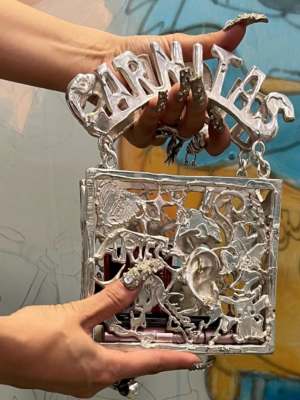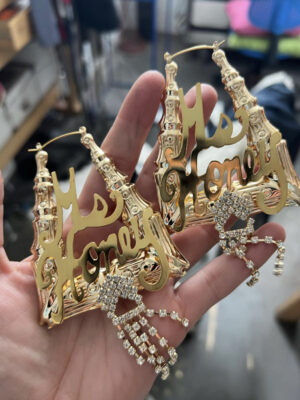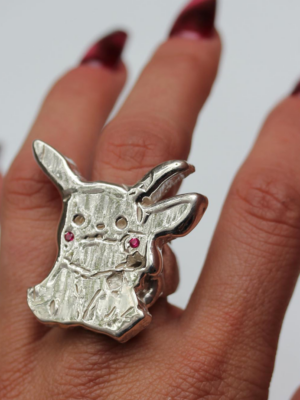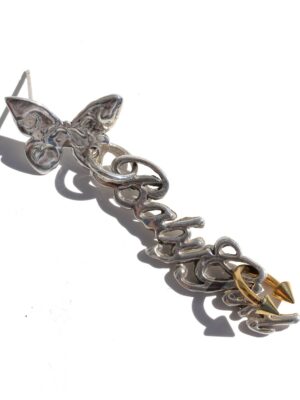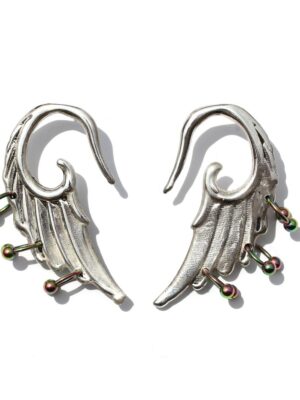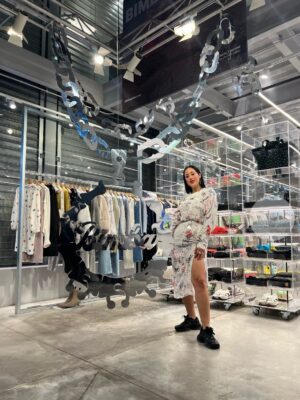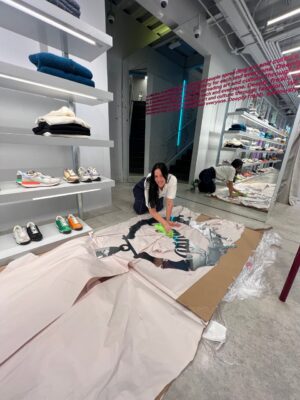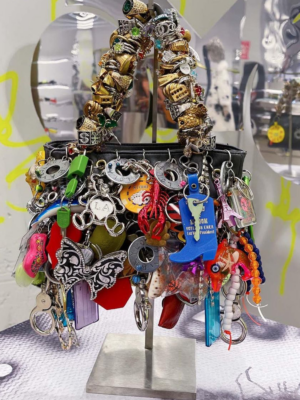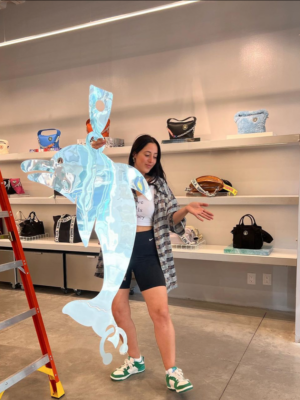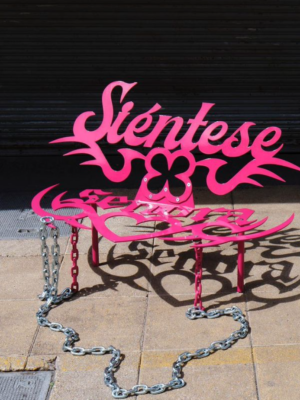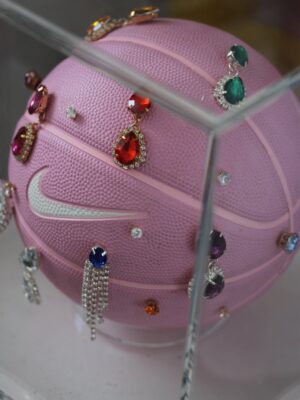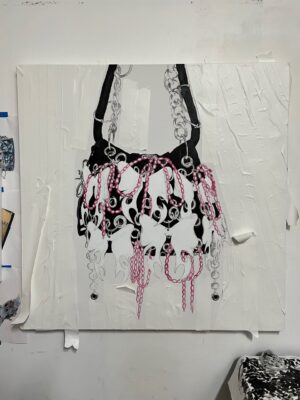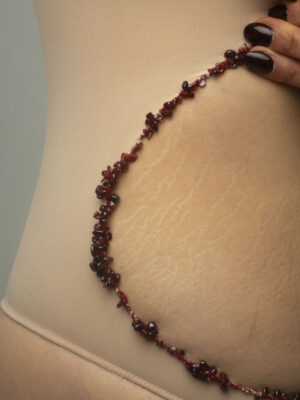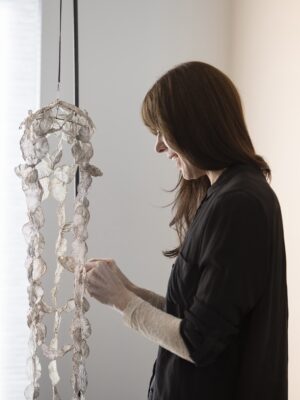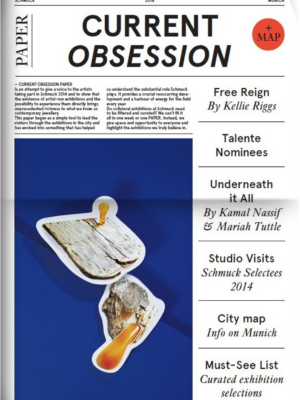Her strongly rooted sense of self has gained her countless collaborations with fellow artists as well as big brands such as Fenty, Nike, e.l.f. Cosmetics, and most recently Bimba y Lola. Also in line are Beyonce, Rosalia, Lizzo, Doja Cat, and Bella Hadid, to name a few, who have all worn her works.
We caught up with Treviño as she was about to start a packed working day at her San Diego studio. The interview was composed and conducted by the participants of GEMZ, CO’s very own talent development programme.
Current Obsession: While researching you I encountered the term ‘bicultural’ – could you expand on how it affects you as an artist? How do you balance implementing elements from your cultures into your works?
Georgina Treviño: I’m a border artist. I was raised between Tijuana and San Diego and so I feel like I am bi-cultural, I live in two worlds at once. I pay attention to all the details in both worlds. Being raised on the border, you see a lot of my culture; we have a lot of Mexicans in San Diego. I also travel a lot to Mexico City. I used to live there, so as far as inspiration goes, I try to always go and come back.
CO: Can you walk us through some of your pop culture references and how you choose which ones to work with? It seems like you are re-contextualising American pop culture by treating it with Latin street culture in some of your work.
GT: I feel I’ve always stayed true to myself, to what I like. Everything I’m inspired by I try to incorporate into my work, and then to maybe have this Latin twist. Honestly, it is not a specific motive, I feel like I am unconsciously doing it. I just try to stay true to myself but it all comes from stuff that I’m interested in, it’s very genuine. I feel people sometimes think too much. As artist you should just be your own self and let things speak for themselves, it’s just me in the work.
Treviño’s work incorporates pop culture imagery and typography
___STEADY_PAYWALL___
CO: In what way do you do research for your work? I read you get a lot of inspiration from typography in Mexico.
GT: My latest body of work is based on typography found in the Roma area in Mexico City. The typography was taken away by the government, they decided to wipe off all this beautiful rótulos (hand painted signs that serve to advertise). Beautiful imagery and typography that had been there for years, and they decided to wipe it off for the tourists, so it seemed more ‘clean’. I’m interested in the street, colourful stuff and how people maybe mix in English words. There’s so much humour there, I think Mexico can have this tacky feel but in a beautiful way, so I’m interested in how people perceive that.
I can imagine the government thought that this was tacky, and I get why they’d do it for tourism. But I see it as Mexican patrimony, it is beautiful artwork they have wiped off. People are very against this, they got mad. It was very sad and ignorant from the government to think that they could wipe it off. In my last work I did a sterling silver purse that is based on this, I collated different imagery, different elements from photos that I had collected.
I call my friends and I ask, ‘is this too much?’ … when is it really too much? But I’m too much, you know?
CO: Your artistic style is very visual and intuitive. Do you also focus on the theoretical side of things, or do you tend to do less of that?
GT: Not so much, I have to when it comes to gallery stuff. I wrote an article last year on ornamentation, exploring when is being ‘too much’ or how do we stop an artist and asking when is it ‘too much.’ I call my friends and I ask, ‘is this too much?’ Like what I’m wearing or is this too much with my work and I question when to stop, when is it really too much? But I’m too much, you know?
CO: From what I have seen, collaboration with others is a big part of your work. What do you look for in a collaboration? What collaboration has been the biggest success, and when does it not work out?
GT: I think since day one I’ve been collaborating. Even at college I was thinking who’s going to take my photos, trying to get friends to help me or doing trade-offs. I’m always approaching people, like makeup artist or photographers. I love that you get to reach another audience I think that’s beautiful, and also making friendships. All these collaborators I work with I’m good friends with now. No matter what you’re going to become friends because you’re interacting, you’re exchanging ideas and concepts. For me I love people, I love making friends. That is one of the biggest parts of collaboration is that I make beautiful relationships.
I just worked with probably my biggest collaborator; a Spanish brand called Bimba y Lola. I created art for their store; sculptures and some other installations and we made some workshops in the stores. I think this has been my most successful collaboration. I became friends with them all, now they’re like family. This is a brand with a lot of money. The cool thing about collaborating in this way, is that they will push me to make work that I wouldn’t do on my own, there was budget! I think the artist must be 100% happy when collaborating because it also affects your brand, you must stand up for yourself.
Treviño’s collaboration with Spanish Brand Bimba y Lola
CO: How did you start working with stylists? How do you go about being credited for your works as a part of these type of collaborations?
GT: When I lived in Mexico City, I met one of my best friends. She is a stylist and at the time she was asking me for pieces for editorial work and I just let her borrow them. This was for like Marie Claire or Elle, and it was early in my career. I was still making work for school, and I just let her borrow them. I then began creating content, content, content for my Instagram. One thing just leads onto the next; work makes work I would say. Now stylists reach me definitely because of my Instagram, that has been important. In 2020, this was when more stylist started reaching out. I think because of showrooms being closed due to COVID; word spread that I was making jewellery and making jewellery quickly from my studio. Stylists would contact me, and often jewellery is the last thing they think about it, and they’d be asking if I could do things for the next day. I would go crazy in my studio all night and be making whatever.
A lot of stylists are in Los Angeles; so, me being where I am at helps because I can meet them easily. From here some of the stylists who contacted me in 2020 then went onto become regular clients, that trust my work. Now they may just give me a mood board, or a budget and they will trust me to create work for them. Sometimes I see artists’ stylists go straight to my website and buy from there, which is beautiful because to me it says that they value me. Recently people are commissioning work instead of loans which is great because I get more excited when I do a more custom work versus something that already exists. I’m like the ADD of making, I have to be making things, every time I’m in my studio I have to make one thing. Even if it’s just something stupid, it’s part of me, part of my DNA. A lot of times there’s never money for jewellery, it is the last thing they think of, which I hate. I think it’s beginning to be more important, there’s a change that is happening and people are investing a little more.
I think big brands feel they need to collaborate with young artists. They have the need to be part of us, to be part of this generation.
CO: What unique characteristics or qualities do you think attracts collaborators to you? Are you able to explain in a more general way, what you think, for example brands are looking for when working with independent artists and designers?
GT: I think big brands feel they need to collaborate with young artists. They have the need to be part of us, to be part of this generation. They want to be relevant, and they want to stay fresh; I feel brands are starting to get boring maybe because we see a lot of makers on social media, on TikTok sharing their craft.
Perhaps there is a need for brands to be a part of this and not just be mass produced and boring. I think it’s really cool for them to collaborate with artists who are not even big. That’s beautiful because for young artists it gives us hope, you think “that could be me”. I feel like they should be approaching all of us makers no matter how much following you have, if you have beautiful work, it has potential.
CO: During the peak of the corona crisis in 2020, you began (virtually) collaborating with a variety of artists. Could you tell us more about this initiative and what is has taught you?
GT: I started freaking out because I’m a crazy maker. I started thinking that I wouldn’t have stuff to make because of COVID. I curated a list of people whose work I enjoyed and reached out to them for this reason. I didn’t choose someone because of their following numbers, nothing like that. Nothing was planned to be honest; but I had this list of people, and I love to make new things, and I also wanted to help other artists.
The idea was for me to make one or two pieces with them and sell them online. I would give 40% or 50% of the sale, and they would be getting exposure through my social media. It was very fun and is something that I’d like to do more of. I started doing more wearable stuff through this, I did a couple t-shirts designs and purses too. I even did a collaboration with a beer brand from Tijuana, which is something I never thought I would do. It was with artists from all over the world. Sometimes there was an exchange or helping each other with things we’re good at or maybe pushing them to explore something, and this worked both ways.
CO: You’re incredibly current and up to date with your social media presence and it seems to come very natural to you. Would you have any tips to make the best use out of it, enjoy it and grow the presence and possibilities of it?
GT: I do enjoy it, and I see it as a diary for myself. Instagram, I know some people hate it, but it has taken me to so many places and helped me reach out to people and document my work. I make something, and I want to share it with the world, and social media has enabled me to do so. I only have Instagram. I’m trying with TikTok, but I feel too old for it.
Sometimes you feel pressure and feel like you have to post, but it’s important to keep the vibe genuine. If you’re not feeling it, it can seem forced. However, don’t be afraid to post. Sometimes you might be working on something, and you might think “this is so ugly,” but then you post it, and everybody loves it. You really never know; you never know if that person you admire is going to see your post or answer your message and collaborate with you. Posting online can help you see your work in a different light, or maybe someone else can see something that you didn’t. Posting your work can be advantageous, even if it’s still in the process. People might feel scared to share their unfinished work, but I think this is also what people want to see. Other makers certainly do, and I think clients do as well. Big brands mass-produce their products and are not able to show this side, and that’s what makes us unique. It gives us more value versus a brand.
Also, don’t post pictures of your boyfriend or your child. You need to take it seriously and have a clean aesthetic. I think you need to keep your work and personal life separate. Your social media can be essential. For me, I imagine what if my biggest idol were to look at my Instagram. Fake it till you make it, think and act like you’re bigger than you are.
Examples of Treviño’s work outside of Jewellery design
CO: Did you work in big jewellery companies before starting your own business or did you start your own brand as soon as you left school? And if so, do you think it is necessary to have a working experience in big (fashion) companies to succeed in the jewellery industry?
GT: I have never worked in a company. I knew I wanted I wanted to sell jewellery and have a brand. I started a brand when I was in school, maybe two years before graduation when I went to Mexico City. I took a leave of absence from university; I went to Mexico and that was where I did my first sell ever. Then I just kept going, I finished school and then I rented a studio and I just started making. I had no idea what I was doing, and I just let the work lead me. You just have to be patient and positive. I’m not where I want to be yet, but I graduated 2014 so back then I didn’t know what I was doing and my brand has changed completely.
I don’t think you need to have experience in business; you just have to stick to what you really want. I’ve had other jobs too, but you have to be willing to make sacrifices and be serious about it. If you want to pursue jewellery-making, you have to give 100% of yourself. It’s hard because I come from a contemporary jewellery background, and in school, you’re not taught to sell your work; you’re taught to create ‘art jewellery’. In my case, I try to keep my art jewellery separate from my production work, so I feel that’s where the money can come from. Everybody needs jewellery, so there’s always a market to sell to.
CO: You’ve said that jewellery is often perceived as just jewellery and not often recognised as art. I’m curious to know how you started exhibiting and developing relationships with art institutions?
GT: If you come from a contemporary jewellery background, we have spaces like Munich or New York Jewellery week, and there are different galleries or exhibitions, but it just feels like a different world. It is a very compressed world, that is just that.
In general, I’m interested in having big institutions represent us and see us as artists. That’s hasn’t really happened, you have sculpture, painting, photography but jewellery isn’t there. It is in some museums and it’s starting to happen, but I think we should push that it is art. I think you have to be serious and reach out, there’s always calls for openings and exhibitions. If you really want to get into that start talking and start applying, things are not going to come to you. You have to reach a little and they come to you.
You’re not going to make anything if you’re not making, the work is going to lead you. I believe work makes work.
CO: What are some of your plans for the future?
GT: I want to keep going with my artwork and grow in that area and grow my brand too. I would love to be the creative director of a jewellery brand; I would love to direct. Also, to have a space in Mexico, where people can have residencies or come to stay or rent a space. Mexico still has a lot of work to do in contemporary jewellery and I want to be a part of helping that grow; to have a bigger, stronger community. Pre-pandemic I was supposed to be open a showroom space, but everything got screwed up but I’m trying to retake that idea, but I’m just getting started.
CO: What is your number one piece of advice for starting your own jewellery practice after just graduating?
GT: Number one: just keep going, don’t let anything stop you. There are so many things we see failures or as bad things, but I think they’re all good things. Use it to motivate yourself, prove people wrong. I honestly don’t know what I’m doing a lot of the time, I’m letting the work be and riding it. You’re not going to make anything if you’re not making, the work is going to lead you. I believe work makes work. The moment your hand touches the metal, the material, your bench it’s like magic. Don’t be afraid of failure, reach out, be true to yourself, you need to be connected to the work.
CO: This is us at the end of the interview, thank you very, very much.
GT: Thank you so much everyone, I really enjoyed it. Have a beautiful day, thank you x
This interview was edited for clarity.

